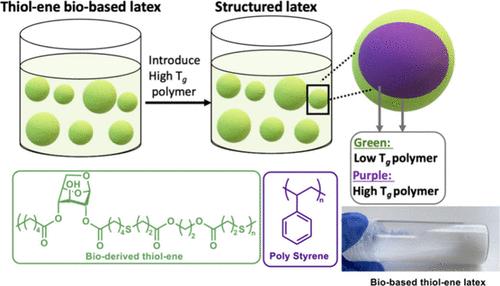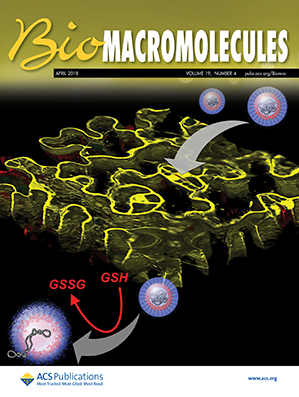Bioderived Thiol–Ene Emulsion Polymerization for Hybrid Latex Particles
IF 5.5
2区 化学
Q1 BIOCHEMISTRY & MOLECULAR BIOLOGY
引用次数: 0
Abstract
The thiol–ene emulsion polymerization of three dienes synthesized from bioderived compounds, and subsequent preparation of core–shell polymer latexes, is reported. Levoglucosan (LGA), levogucosenone (LGO) and isosorbide were first modified with 4-pentenoic acid to install polymerizable groups. These monomers were used along with a dithiol to prepare poly(thioether) particles via ab initio emulsion polymerization using potassium persulfate as initiator and sodium dodecyl sulfate as surfactant. The structure of the diene significantly influenced the size of the resulting polymer latex particles. Given their low glass transition temperature, the LGA-derived poly(thioether) particles were used as a seed for the seeded emulsion polymerization of either styrene or methyl methacrylate. Core–shell latex particles with a high Tg core and a low Tg bioderived shell were formed, as verified by electron microscopy and in agreement with theoretical predictions of the equilibrium particle morphology based on the interfacial tensions of each particle phase.

生物巯基炔乳液聚合技术用于混合胶乳颗粒
本研究报告介绍了从生物源化合物中合成的三种二烯的硫醇-烯乳液聚合以及随后的核壳聚合物胶乳制备过程。首先用 4-戊烯酸对左旋葡聚糖 (LGA)、左旋葡烯酮 (LGO) 和异山梨醇进行改性,以安装可聚合基团。以过硫酸钾为引发剂,十二烷基硫酸钠为表面活性剂,通过自始乳液聚合法,将这些单体与二硫醇一起用于制备聚硫醚颗粒。二烯烃的结构对所得聚合物胶乳颗粒的大小有很大影响。由于 LGA 衍生的聚硫醚颗粒的玻璃化温度较低,因此可用作苯乙烯或甲基丙烯酸甲酯种子乳液聚合的种子。经电子显微镜验证,形成了具有高 Tg 内核和低 Tg 生物衍生外壳的核壳胶乳粒子,这与基于各粒子相界面张力的平衡粒子形态理论预测一致。
本文章由计算机程序翻译,如有差异,请以英文原文为准。
求助全文
约1分钟内获得全文
求助全文
来源期刊

Biomacromolecules
化学-高分子科学
CiteScore
10.60
自引率
4.80%
发文量
417
审稿时长
1.6 months
期刊介绍:
Biomacromolecules is a leading forum for the dissemination of cutting-edge research at the interface of polymer science and biology. Submissions to Biomacromolecules should contain strong elements of innovation in terms of macromolecular design, synthesis and characterization, or in the application of polymer materials to biology and medicine.
Topics covered by Biomacromolecules include, but are not exclusively limited to: sustainable polymers, polymers based on natural and renewable resources, degradable polymers, polymer conjugates, polymeric drugs, polymers in biocatalysis, biomacromolecular assembly, biomimetic polymers, polymer-biomineral hybrids, biomimetic-polymer processing, polymer recycling, bioactive polymer surfaces, original polymer design for biomedical applications such as immunotherapy, drug delivery, gene delivery, antimicrobial applications, diagnostic imaging and biosensing, polymers in tissue engineering and regenerative medicine, polymeric scaffolds and hydrogels for cell culture and delivery.
 求助内容:
求助内容: 应助结果提醒方式:
应助结果提醒方式:


